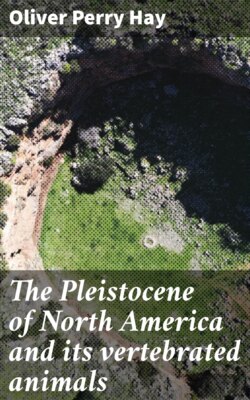Читать книгу The Pleistocene of North America and its vertebrated animals - Oliver Perry Hay - Страница 7
На сайте Литреса книга снята с продажи.
II. The Blanco Pliocene.
ОглавлениеTable of Contents
The Blanco is held to belong to the upper, or to the uppermost, Pliocene. It is at present assigned to the Middle Pliocene (Osborn, Bull. U. S. Geol. Surv. No. 361, p. 81; Matthew, ibid., p. 120). Until recently the oldest known Pleistocene vertebrates appeared to be represented by the collections which long ago were made at Fossil Lake, Oregon, and at Grayson (Hay Springs), Nebraska. These assemblages had formerly been referred to the Pliocene, and the belief that they belong there is not yet wholly without supporters. It seemed, therefore, proper to retire the Blanco somewhat. The discovery that the Fossil Lake and Grayson faunas were represented in the Aftonian deposits of Iowa, and belonged probably to the first interglacial stage, reveals the fact that the geological interval between the Blanco and the Aftonian is at least partly filled by the first glacial stage, the Nebraskan. Naturally, it is to be expected that the breach between the earlier and the later faunas will be occupied, in part at least, by the vertebrates of the Nebraskan. What these are is not yet well determined; but the writer believes that as the Blanco and its equivalent and closely related formations and faunas become better known, they will be attracted close to the Pleistocene.
Aside from the facts just mentioned, the Blanco fauna seems to the writer to be more closely related to the Aftonian than has been supposed. The genera which occur in the Blanco are the following:
Megalonyx.
Mylodon.
Glyptotherium.
Hipparion.
Pliohippus.
Protohippus.
Platygonus.
Pliauchenia.
Anancus.
Gomphotherium.
Stegomastodon.
Felis.
Amphicyon?
Borophagus.
Canimartes.
Of these, Megalonyx, Mylodon, Hipparion, Platygonus, Anancus, Gomphotherium?, Stegomastodon, and Felis are known from the first interglacial stage. Anancus includes mastodons with short, tuskless lower jaws and trefoiled molars. Gomphotherium, having long lower jaws with tusks, upper tusks with enamel band, and with trefoiled molars, may be represented by some of the early Pleistocene species. The same species of Stegomastodon appears to be present in the Blanco as in the Pleistocene, S. mirificus. The edentate Glyptotherium is not far removed from Glyptodon of the early Pleistocene. The Blanco genera of horses are so close to Equus that Cope regarded them as belonging to this genus.
The matter may be looked at from another point of view. If Mylodon, Megalonyx, and Glyptotherium are referred to the Middle Pliocene, we shall probably have them recorded as living in Texas before they existed in South America. It is true that Santiago Roth (Neues Jahrb., Min. Beil., Bd., vol. XXVI, table opposite p. 144) states that Glyptodon occurs in the Lower Pampas beds, and these he refers to the Upper Miocene; but the writer believes that Wilckens (Neues Jahrb, Min. Beil., Bd., vol. XXI, p. 193) is more nearly correct in placing them in the Pliocene. While the opinion may be correct that, when no obstacles intervene, the time required for mammals to spread over even a continent constitutes but a small part of a geological age, yet in making their way from South America, especially from Argentina, along the narrow bridge that appears to have been offered them, probably over mountain ranges, and across rivers and gorges, and in the face of the competing fauna advancing from the north, some of which were wolves and saber-tooth tigers, the slowly plodding and inoffensive edentates would have encountered too many hindrances to be able to make the journey in a short time.
The writer, therefore, ventures to range the Blanco immediately below the Pleistocene. On about the same level may be placed the Tulare-Etchegoin and the Thousand Creek formations of Merriam (Bull. Dept. Geol. Univ. Calif., vol. X, pp. 425, 429).
